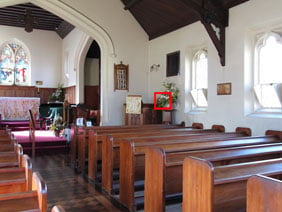Canon PowerShot SX200 IS
-
-
Written by Gordon Laing
Canon SX200 IS vs Panasonic TZ7 / ZS3 vs Canon SX10 IS High ISO Noise
Canon PowerShot SX200 IS results : Real-life resolution / High ISO Noise
Canon PowerShot SX200 IS results : Real-life resolution / High ISO Noise
|
 |
To compare noise levels under real-life conditions we shot this scene with the Canon PowerShot SX200 IS, Panasonic Lumix TZ7 / ZS3 and Canon PowerShot SX10 IS within a few moments of each other using each of their ISO settings. The lenses on each camera were adjusted to deliver the same field of view, as much as their zoom steps would allow. Both Canons were set to Program and the Panasonic to Normal mode to evaluate their automatic performance. |
The image above was taken with the Canon PowerShot SX200 IS at a sensitivity of 80 ISO, with the lens set to 6mm (34mm equivalent); the exposure was 0.6 seconds at f3.4 and the original Large Fine JPEG file measured 2.3MB. The crops are taken from an area marked by the red square and presented at 100%. The Panasonic TZ7 / ZS3 and Canon PowerShot SX10 IS crops show a slightly larger area because of their slightly lower resolution.
At 80 ISO, all three cameras are delivering images with plenty of detail as you’d hope. Pixel-peepers may notice fractionally greater detail on some of the leaves on the SX200 IS over its rivals, thanks to its slightly higher resolution, but it’s very subtle and certainly not a deal-breaker for the others. Panasonic’s TZ7 / ZS3 is once again illustrating punchier image processing, but even at this lowest sensitivity there’s greater evidence of noise textures in the background than the Canons.
At 100 ISO all three are showing subtle textures in the background, although again they’re more apparent on the Panasonic due partly to its lower noise reduction. The good news is there’s still lots of detail on all three.
At 200 ISO noise processing artefacts have again increased, with the most obvious speckles again on the Panasonic crop. The result from the SX200 IS though is beginning to look soft, lacking the impact of the others, and this is a trend that continues throughout the range, most probably due to packing-in those extra pixels in the same sensor area.
With the sensitivity increased to 400 ISO there’s a drop in quality from all three models, and this is about as far as you’d want to take any of them while retaining a decent amount of detail. Interestingly despite exhibiting greater noise at earlier sensitivities, it’s the Panasonic TZ7 / ZS3 which is now looking a little better.
This difference becomes more apparent at 800 ISO where both Canons have become noticeably softer than the Panasonic, especially the SX200 IS. Noise reduction is attempting to eliminate any visible speckles from the SX200 IS, but at the cost of detail, with the result looking worst of the three models.
At 1600 ISO this mushiness increases further on the SX200 IS, and while the Panasonic clearly has more visible noise speckles, its result is far preferred.
Finally, all three models offer higher sensitivities at a reduced resolution: both Canon’s have a 3200 ISO preset which operates at 2 Megapixels, while the Panasonic has a High Sensitivity preset which drops the resolution to 3 Megapixels and operates between 1600 and 6400 ISO. The bottom line though is none look good.
Ultimately the SX200 IS enjoys a very slight detail advantage at 80 ISO thanks to its higher resolution in this particular test – although we didn’t notice a great deal of difference in the tests on the previous page. Unfortunately any resolution benefit of the SX200 IS is quickly lost as the sensitivity increases. By 200 ISO, the SX200 IS is beginning to show the signs, and at 400 ISO upwards, the two 10 Megapixel models here take the lead. Now head over to our Canon PowerShot SX200 IS Gallery to see some more real-life shots in a variety of conditions.
Canon PowerShot SX200 IS |
Panasonic Lumix DMC-TZ7 / ZS3 |
Canon PowerShot SX10 IS | ||
 |
 |
 | ||
80 ISO |
80 ISO |
80 ISO | ||
 |
 |
 | ||
100 ISO |
100 ISO |
100 ISO | ||
 |
 |
 | ||
200 ISO |
200 ISO |
200 ISO | ||
 |
 |
 | ||
400 ISO |
400 ISO |
400 ISO | ||
 |
 |
 | ||
800 ISO |
800 ISO |
800 ISO | ||
 |
 |
 | ||
1600 ISO |
1600 ISO |
1600 ISO | ||
 |
 |
 | ||
3200 ISO (at 2 Megapixels) |
1600 ISO (at 3 Megapixels) |
3200 ISO (at 2 Megapixels) |




